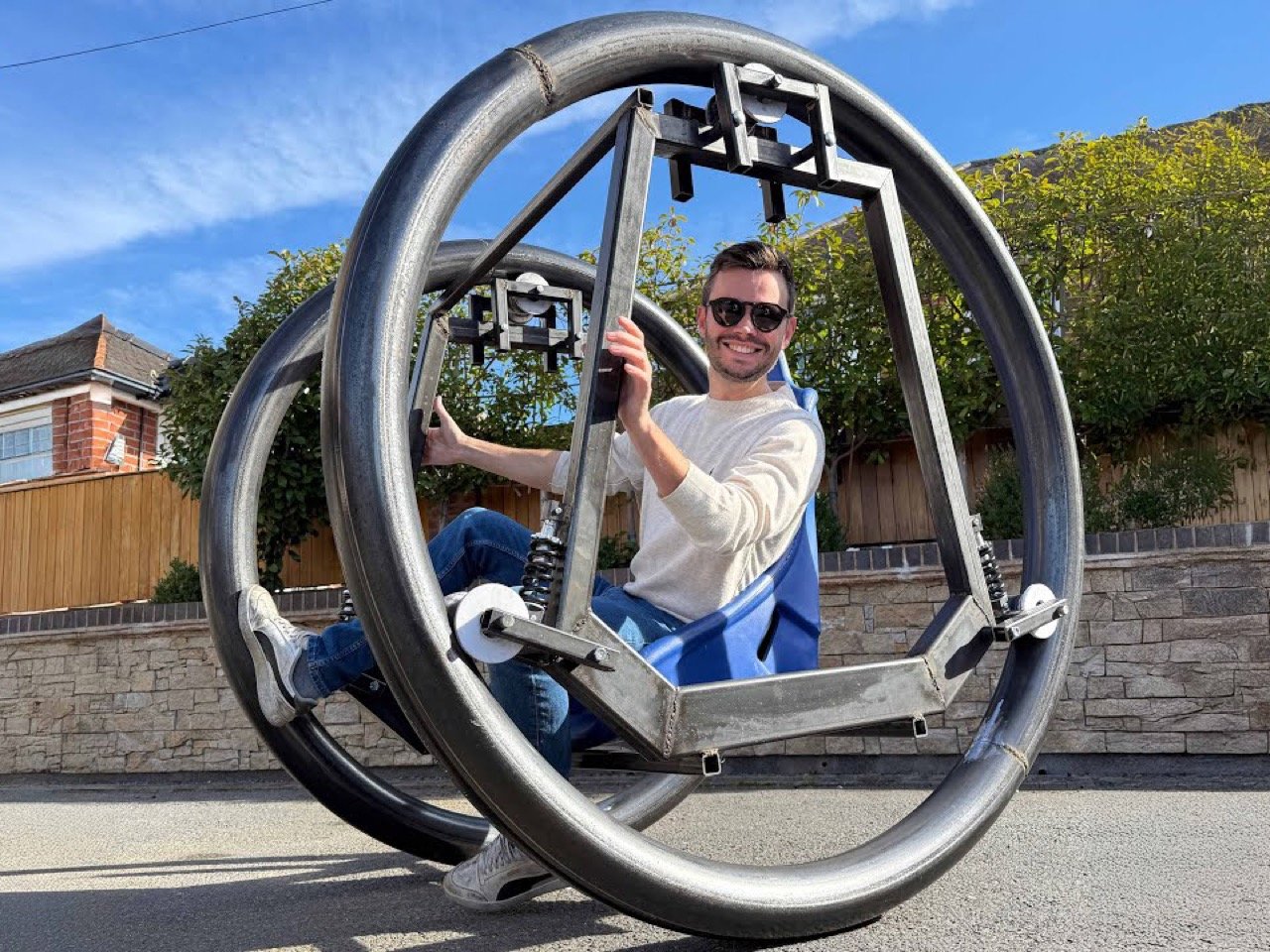Sam Barker’s first monowheel was a disaster. Built in his kitchen four years ago, it flexed, it had bolts sticking out everywhere, and he fell off it multiple times. Most people would call that a learning experience and move on to safer hobbies. Barker decided to double down and build something even more ambitious: a diwheel powered by 60 kilowatts of electric motor.
For the uninitiated, a diwheel (or dicycle, depending on who you ask) consists of two large rings with the rider sitting in a frame between them. Unlike a monowheel, which requires constant balance and gyroscopic forces to stay upright, a diwheel is naturally stable. The outer rings rotate around a stationary inner frame via roller bearings, and the whole thing steers like a tank: differential power to each wheel. It’s the kind of vehicle that makes you wonder why we ever settled on boring old bicycles, right up until you try to navigate a doorway or park the thing.
Designer: Sam Barker
Barker’s approach to the rebuild borders on industrial overkill. The steel tubing for the rings measures 5mm thick and 100mm wide, sourced from a Sheffield metalworker who reported extraordinary difficulty even cutting and rolling the material. Each completed ring weighs 60 kilograms. For context, that’s heavier than most complete electric bicycles. The builder openly admits to over-engineering: “Have I gone over the top? Yes. Am I scared it’s going to run away with all the inertia? Yes. Is it going to bend? Absolutely not.” This kind of self-awareness is refreshing because it acknowledges the fundamental problem with amateur fabrication. When your welding skills are questionable and your measurements keep coming out wrong, you compensate with materials that could probably survive a tank rolling over them.
The ring construction alone turned into a multi-day nightmare. The Sheffield shop couldn’t roll the steel into complete circles without them ending up flat on the floor, so Barker had to cut each ring in half, attempt to align them perfectly, and weld them back together. Spoiler: they didn’t align perfectly. The gaps required creative clamping solutions and what he diplomatically calls “bodge” techniques. He built the first inner frame using 3D-printed templates, only to discover catastrophic measurement errors that forced a complete rebuild. The second frame copied the corrected dimensions but somehow still ended up a different size. Wrestling 60-kilogram rings into place solo nearly got him crushed when one started tipping. The whole process reads less like precision engineering and more like an extremely dangerous puzzle where every piece weighs as much as a small person.
His original monowheel used PLA 3D-printed rollers that lasted about 10 minutes before disintegrating. The new build features nylon SLS-printed rollers designed in Fusion 360 and manufactured through an online service with a 48-hour turnaround. Each roller houses four bearings (two center, one at each end) for load distribution. The suspension system exists primarily to accommodate construction mistakes, which is perhaps the most honest engineering justification I’ve ever heard. He needed 17mm bearings, couldn’t find rod stock that would fit through them, and ended up building a makeshift lathe from 3D-printed parts and a drill. This hybrid approach captures something essential about modern maker culture: CAD software and cloud manufacturing services combined with traditional metalwork and whatever happens to be lying around the workshop.
The diwheel currently rolls acceptably within its rings, which feels like damning with faint praise until you consider the fabrication chaos that preceded it. The racing bucket seat (sourced from Facebook Marketplace, naturally) isn’t mounted yet because Barker wants to finalize battery and motor placement first. Smart move. With 60kW on tap, weight distribution matters enormously. That power figure puts this build in the same league as many motorcycles, which raises obvious questions about what happens when all that rotating mass gets up to speed. Natural stability is one thing at walking pace. Natural stability at 50 kilometers per hour with hundreds of kilograms of steel spinning around you is something else entirely. The real advantage over his failed monowheel comes down to physics: diwheels don’t rely on gyroscopic forces to stay upright, which means they’re stable even at rest. Add electric drive with independent motor control for each wheel and you get tank-style steering without the constant terror of toppling over.
The real test comes in part two when he actually rides this beast. Until then, we have documentation of every measurement error, every misaligned weld, and every moment where heavy steel nearly crushed its creator. That honesty makes this build worth following… and if you dare, imitating too.
The post DIY Diwheel uses 60kW Motorcycle Power and Tank Steering… but will it drive? first appeared on Yanko Design.

